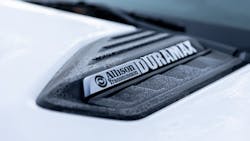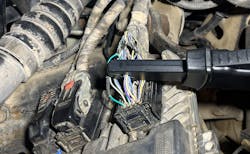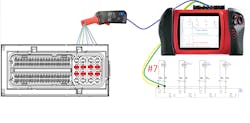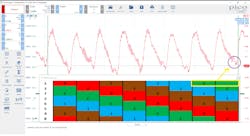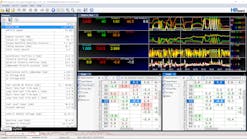Content brought to you by Motor Age. To subscribe, click here.
Welcome back to another edition of “The data doesn’t lie,” a regular feature in which I pose a puzzling case study, followed by the answers to the previous issue’s puzzle.
What You Will Learn:
• Diesel injector balance rates can be thought of as individual injector fuel trim and can indicate an ECU's intent for compensation
• A misfire is simply a slowing of the crankshaft
• The approach to diesel driveability is the same mindset for that of a gasoline powered engine
Today’s challenge comes from my friend, Jonathan Martin. It’s a Chevy truck with a 6.6L Duramax diesel engine exhibiting misfire under lightly elevated rpm. The vehicle came from an auction, so its history is unknown. Jonathan connected his Mac Tools MDT10 scan tool, and the collected data indicated cylinder #7 was the culprit. I advised Jonathan to monitor the injector balance rates, as they may provide some easy-to-obtain information.
Individual injector balance rates are very similar to fuel trim (on a gasoline engine) in that they are corrective factors. They differ from fuel trim in that they are per individual injector, not an entire bank of fuel injectors. Negative rates indicate a reduction in fuel delivery to that cylinder, and positive rates indicate an increase in fuel delivery to that cylinder. Referencing balance rates can offer some clues, as they are compensating for variations in crankshaft speed.
Preliminary data
Clearly, the captured data (when plotted in a graph, pardon the approximation) shows a trend in that cylinder #7 contributes the least to the crankshaft speed (Figure 1). A relative compression test revealed virtually no variation in starter load from cylinder-to-cylinder.
I then advised Jonathan to evaluate the injectors’ performance with a lab scope and amp probe. Jonathan mated his Pico 4425Ascope and TA473 amp probe to the injector circuits (Figure 2+3). The current ramps for each injector are all of the same amplitude, indicating electrically they are all performing the same work. Although it is normal for diesel injectors to multistrike, Injector #7 is energized at least twice as many times as the other injectors. This is evident by the number of consecutive pulses (Figure 4).
This engine has already had the #7 injector replaced twice (both from General Motors). The tech reached out for my input, as he is no longer confident in his diagnostic approach or the information he had previously analyzed.
The data doesn’t lie
With all the information in front of us, we are faced with deciding how to proceed. Here are some bullet points of what we know to be factual, and I will ask all of you, diligent readers, for your input:
- Cylinder #7 is misfiring erratically (Injector has been replaced twice with GM injectors)
- Injector current ramps are equal in amplitude
- No cylinder integrity issues evident in relative compression trace
- Injector balance rates align with symptom (#7 weakest contributor)
Given this information, what would you do next?
- Replace the injectors
- Send the cylinder head out for machine work/inspection
- Replace fuel/ inspect for contamination in fuel/rail
- Test for low-pressure fuel system supply issue
SOLVED: (September 2023, Motor Age) 2017 Ford F150 5.4L, Misfire at tip-in
What would you recommend doing next, given the data bullet points in last month’s challenge?
- Replace spark plug for cylinder #1
- Perform induction cleaning service
- Clean VVT oil control valve #1
- Perform cranking pressure waveform analysis on intake and/or exhaust system
For those of you who chose answer #4, congratulations! The evidence presented in the captured ignition waveform indicates a variation in conductivity within the combustion chamber. This could be caused by poor injector spray pattern, EGR dilution, or air/fuel charge displacement from a cylinder leakage. Although the relative compression test is used to reflect starter load variations per cylinder, it didn’t indicate a large leak. With a small loss of charge, the starter amperage draw didn't change significantly. However, the disruption within the cylinder (due to charge displacement past a leak point) can hinder the combustion process and create a misfire.
While cranking the engine, an anomaly could be seen in the cranking intake trace (Figure 5). Each time the suspect cylinder (Cylinder #1) was on its compression stroke, the correlating intake manifold vacuum pull (from the # 6 induction stroke) suffered. This alluded to a poorly sealed #1 intake valve.
Answer #1 is not the best answer, as the fault only occurs under light load. Compromised spark plugs more often exhibit a driveability symptom under heavier engine loads, as the spark tends to deviate toward the easiest path to ground.
Although answer #2 is a valid test, it's best to prove a fault rather than to begin introducing repairs and services as a experimental countermeasure.
Answer #3 is incorrect; although bank-to-bank VVT issues can create driveability faults, it will affect an entire engine bank on this V8 engine design. It will also cause bank-to-bank fuel trims to oppose/mirror one another (for instance Bank #1= -18% / Bank #2= +18%).
Be sure to read December's issue of Motor Age for the answer to this month’s challenge and what was discovered!
